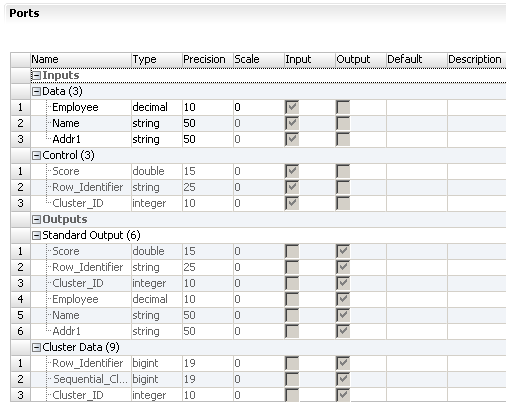Ports
The Duplicate Record Exception transformation has multiple groups of input and output ports.
The following figure shows an example of the input and output ports:
Duplicate Record Exception Transformation Input Ports
A Duplicate Record Exception transformation has a Data group and a Control group of input ports.
The Data group contains user-defined ports that receive the source data.
The Control ports receive metadata that the Match transformation adds to the source data. The following table describes the Control ports:
Port | Description |
|---|
Score | Decimal value between 0 and 1. Identifies the degree of similarity with the record that linked the record to the cluster. |
Row_Identifier | A unique identifier for the record. |
Cluster_ID | The ID of the match cluster to which the record belongs. |
Duplicate Record Exception Transformation Output Ports
The Duplicate Record Exception transformation has multiple output groups. By default, the transformation writes duplicate records to the Standard Output group. The transformation writes potential matches to the Cluster Data group. You can add an output group for unique records.
You can change the record types that the transformation writes to output ports by changing the default settings on the Configuration view.
The following table describes the output ports for the Standard Output group:
Port | Description |
|---|
Score | Decimal value between 0 and 1. Identifies the degree of similarity between the record and another record in a cluster. |
Row_Identifier | A unique identifier for the record. |
Cluster_ID | ID of the cluster that the Match transformation assigned the record to. |
User-defined ports | The source data fields. |
The following table describes the output ports in the Cluster Data group:
Port | Description |
|---|
Row_Identifier | The unique identifier for the record. |
Sequential_Cluster_ID | Identifies the cluster in a Human task. A workflow uses the sequential cluster ID to assign a cluster to an instance of a Human task. |
Cluster_ID | Identifies the cluster that the record belongs to. The Match transformation assigns a cluster ID to all records. |
Score | Decimal value from 0 to 1. Identifies the degree of similarity with the record that linked the record to the cluster. |
Is_Master | String value that indicates if the record is the preferred record in the cluster. By default, the first row in the cluster is the preferred record. Value is Y or N. |
Workflow_ID | ID that identifies the workflow for the record in a task. When you run the mapping outside of a workflow, the workflow ID is DummyWorkflowID. |
User-defined ports | The source data ports. |
Creating Ports
Add each input port to the Data group. When you add the input port, the Developer tool adds an output port with the same name to the Standard Output group, the Cluster Data group, and the Unique Records group.
1. Select the Data input group.
The group is highlighted.
2. Click New (Insert).
The Developer tool adds a field to the Data group, the Standard Output group, the Cluster Data group, and the Unique Records group.
3. Change the name of the field as required.
The Developer tool changes the field name in the other groups.
4. Enter the rest of the ports that you need to add for the data source.

